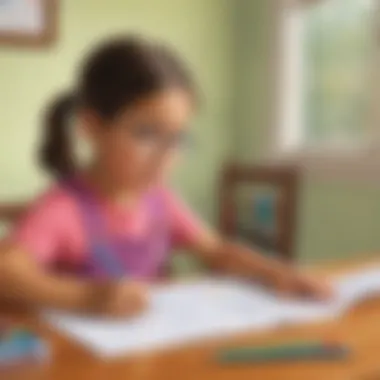Free Printable Math Lessons for Engaging Education


Intro
The world of mathematics can often seem daunting for young learners. However, with the right resources, this can be transformed into an engaging and enjoyable experience. Free printable math lessons offer a strategic way to bridge gaps in understanding while making learning interactive. These materials are both accessible and versatile, allowing for diverse applications in different environments, whether at home or in the classroom.
In this article, we explore the myriad benefits of utilizing free printable math lessons. We will discuss various types of resources available, how they can enhance understanding across essential mathematical concepts, and strategies for effective implementation. By catering to different learning styles, these resources promote independent practice while ensuring that mastery of skills is achieved.
Fun Activities Ideas
Enriching education with fun activities is crucial for maintaining a child's interest. Young learners benefit greatly from engaging experiences that reinforce mathematical concepts in enjoyable ways.
Indoor Activities
Indoor activities can be an excellent way to blend fun and learning. Parents and teachers can use available resources to set up math stations with printable materials. Some interesting activities include:
- Number scavenger hunts using printable worksheets to find numbers around the house.
- Math bingo with customized cards featuring different problems.
- Puzzle challenges where kids solve math puzzles printed on colorful paper.
Outdoor Adventures
Outdoor adventures provide a refreshing context for learning. Kids can engage in activities that incorporate math while enjoying nature. Some ideas include:
- Nature walks where children can measure the height of trees or the distance traveled.
- Outdoor estimation games where learners guess quantities, and then measure to see who is closest.
- Mapping out a treasure hunt that includes distance and direction calculations.
Arts and Crafts
Arts and crafts can integrate math concepts seamlessly. Some ideas might include:
- Creating geometric shape collages using pre-printed shapes.
- Designing number line art that visually represents addition and subtraction.
- Using printable math-themed templates for scrapbooking.
Science Experiments
Integrating science with math can bolster comprehension of both subjects. Some activities involve:
- Measuring ingredients for chemical reactions using printable measurement charts.
- Conducting simple experiments, recording data, and creating graphs.
- Designing experiments that involve statistical calculations, such as averages or percentages.
Cooking and Baking
Cooking is inherently mathematical and can serve as a practical teaching tool. By using recipes that involve fractions and measurements, children learn through doing. Some specific activities include:
- Baking cookies while doubling or halving recipes to understand proportions.
- Creating a cooking journal with printable recipe templates to write down variations and measurements.
"Learning math through engaging activities not only makes it fun but also strengthens comprehension."
In summary, incorporating various fun and pragmatic activities nurtures a positive attitude toward math. Each approach provides opportunities for independent exploration and skill development.
Daily Learning Enhancements
Another facet worth exploring is the variety of free printable materials available online. Many websites offer resources targeted towards different mathematical concepts, such as:
- Addition and subtraction worksheets.
- Multiplication tables designed for practice.
- Fraction exercises with visual aids.
These resources give children the chance to practice over and over, leading to mastery of skills rather than just rote memorization. Teachers might also find these useful to supplement lesson plans, ensuring all students can access the material in their preferred learning style.
Understanding Printable Math Lessons
Printable math lessons are a crucial component of modern educational resources. They offer a practical way to improve students' understanding of math concepts. The flexibility and accessibility of these resources can greatly benefit children, parents, and educators alike.
Definition and Scope


Printable math lessons refer to a wide variety of educational materials available for download and print. These materials may include worksheets, activities, games, and assessment tools. Each type aims to teach or reinforce specific mathematical concepts. They cover basic arithmetic like addition and subtraction, as well as more complex topics such as fractions and geometry. The scope of these lessons can range from preschool to middle school levels, catering to different age groups and learning abilities. This versatility makes them suitable for various environments, including homes and classrooms.
Importance in Education
The significance of printable math lessons in education cannot be overstated. They serve several key purposes that enhance the learning experience:
- Accessibility: These resources are readily available online and can be printed at little to no cost. This accessibility ensures that all students, regardless of their socioeconomic background, can benefit from quality educational materials.
- Support for Different Learning Styles: Printable lessons can be tailored to suit visual, auditory, and kinesthetic learners. This adaptability allows teachers and parents to personalize the learning process, addressing individual needs effectively.
- Encouragement of Independent Practice: By providing a structured format, these lessons promote self-paced learning. Children can work through problems independently, which helps to build confidence and mastery of mathematical concepts.
"Education is a shared commitment between dedicated teachers, motivated students, and enthusiastic parents with high expectations."
Types of Printable Math Lessons Available
The availability of diverse printable math lessons is crucial for both educators and parents. These resources cater to various learning preferences and educational needs. Each type of lesson has distinct features that contribute to a comprehensive educational experience, promoting both understanding and enjoyment in math.
Worksheets for Basic Arithmetic
Worksheets for basic arithmetic serve as a foundational tool in math education. These worksheets often target essential skills such as addition, subtraction, multiplication, and division. They present problems that encourage students to practice their calculations in a structured format. This repetition is vital as it helps reinforce and solidify mathematical concepts, allowing for greater retention over time.
Moreover, these worksheets can be tailored to different skill levels. For example, younger students may work on single-digit operations, while older students might tackle multi-digit calculations. This adaptability makes worksheets a versatile resource in any educational setting.
In addition to practice, worksheets can incorporate visual aids. For instance, illustrations or color-coding can help in distinguishing between different operations, making it easier for learners to grasp the concepts. Using engaging layouts not only enhances the learning experience but also maintains interest in the subject matter.
Concept-Based Learning Materials
Concept-based learning materials go beyond rote memorization. They focus on teaching underlying mathematical principles that form the basis for more complex ideas. These resources often include explanations of concepts like fractions, decimals, and geometry.
Utilizing these materials allows students to connect various math topics. This connection is essential for building a robust understanding of mathematics. For example, demonstrating how fractions can be converted into decimals illustrates their interrelationship, deepening comprehension.
In addition, concept-based materials often include real-world applications. This relevance helps students see the practical side of mathematics, making the subject less abstract and more relatable. For example, applying geometry in the context of architecture or using percentages in budgeting can enhance students' appreciation for the subject.
Math Puzzles and Games
Math puzzles and games provide a unique approach to learning. By integrating fun elements into mathematics, these resources engage students in a different way. They often come in the form of crosswords, Sudoku, and logic puzzles that require mathematical thinking to solve.
Moreover, puzzles can be a highly effective tool for developing problem-solving skills. They challenge students to think critically and logically, providing a break from traditional worksheets while still promoting math practice. Collaborative games also encourage teamwork and communication, skills that are valuable beyond academic settings.
Incorporating these enjoyable activities into lessons can enhance motivation. When students associate math with fun, they are more likely to participate and retain information, leading to a better overall learning experience.
Assessment Tools
Assessment tools are crucial for gauging student understanding and progress. Printable assessments can cover various topics and provide immediate feedback regarding a student's grasp of the material. These tools often consist of quizzes, tests, and self-assessments, allowing both educators and parents to track learning outcomes.
The key benefit of using assessment tools is their ability to pinpoint areas where a student may struggle. For example, if a student consistently misses questions on fractions, focused intervention can be planned to address that specific topic.
Additionally, these tools can facilitate differentiation in instruction. By understanding each student's unique needs and abilities, educators can customize lessons to better suit their learning styles. This tailored approach can lead to enhanced student success and confidence in math.
"Printable math lessons provide a pathway to innovative instructional practices, ensuring each child has a personalized learning journey."
Benefits of Using Free Printable Math Lessons
Free printable math lessons offer various advantages for children, parents, and educators. These resources play a crucial role in making math accessible and engaging for learners of different ages and backgrounds. Many families may find it difficult to afford specialized tutoring or expensive educational materials. This is where free printable lessons come in, proving to be a valuable tool for enhancing mathematical comprehension. In this section, we will explore specific elements that highlight these benefits.
Accessibility and Cost-Effectiveness
One of the most significant benefits of free printable math lessons is their accessibility. With the internet, resources are now just a click away. Parents can find a wide range of materials without spending a dime. This democratization of educational resources ensures that all students, regardless of socioeconomic status, have the opportunity to engage and learn in mathematics.
Cost-effectiveness is not just about zero price tags. It also means that families can allocate their budgets to other essential needs. Websites offering these printable lessons typically provide everything from basic arithmetic worksheets to advanced problem-solving exercises.


- Parents can download and print what they need from home.
- Schools can distribute materials without financial constraints.
- Teachers can easily share resources with each other, fostering collaboration and improving the learning environment.
Customization and Flexibility
Printable math lessons come with a degree of customization that is hard to find in traditional textbooks. Each child has unique learning needs. Some may grasp concepts more quickly, while others might need additional reinforcement. With printable resources, parents and teachers can tailor lessons based on the individual abilities of their students.
Flexibility is another key aspect. Lessons can be printed in different formats to accommodate various learning styles. For instance, visual learners may benefit from diagrams and colorful worksheets, while auditory learners might prefer activities that involve reading aloud or discussions.
- Parents can select the difficulty level that best suits their child's needs.
- Teachers can create a mixed curriculum by combining resources from different sources.
- Families can incorporate math practice into daily activities, making learning more organic and less rigid.
Enhanced Engagement and Motivation
Engagement is a crucial factor in any educational endeavor. Free printable math lessons often incorporate interactive elements that can spark a child’s interest in math. Many worksheets include puzzles, games, and creative problem-solving scenarios. These activities can make mathematics feel less like a chore and more like a fun challenge.
Moreover, the ability to print and use these materials at home or in the classroom allows for increased motivation among students. They can track their progress, see their improvements, and feel a sense of accomplishment. When children can visualize their growth through challenging yet enjoyable activities, it builds their confidence and encourages them to tackle more complex topics over time.
"The right resources can make a world of difference in a child's learning journey."
Implementing Printable Math Lessons at Home
Implementing printable math lessons at home has become a crucial aspect for many parents and guardians. These resources support cognitive development and instill mathematical skills in children of various ages. The accessibility of these materials allows families to complement traditional education methods effectively. It also promotes an engaging learning atmosphere that can enhance understanding of complex subjects.
Creating a Structured Learning Environment
A structured learning environment is foundational for successful implementation of printable math lessons. Children thrive when they have a designated space to focus. A quiet corner equipped with necessary supplies, such as pencils, erasers, and worksheets, can significantly enhance concentration. This setting allows for routine, which can help children become accustomed to learning time. Including a timer may be useful to incorporate timed practice into the sessions; this can help build a sense of urgency and improve focus.
Integrating Lessons into Daily Activities
Integrating math lessons into everyday activities is a practical approach to reinforce mathematical concepts. Simple tasks like cooking can introduce fractions and measurements, while grocery shopping can be a platform for teaching addition, subtraction, or budgeting. Turning these tasks into learning experiences makes the process enjoyable for children. Creating games, like counting items or keeping scores during household chores, will add an element of fun while learning.
Monitoring Progress and Adjusting Approaches
Regular monitoring of progress is essential. Keeping track of children’s performance and understanding aids in identifying areas needing improvement. Parents can keep a journal to document completed lessons and any difficulties faced. Furthermore, adjusting approaches based on this feedback is crucial. If a particular lesson proves too challenging, revisiting simpler concepts may be necessary. Additionally, encouraging children to set small goals can foster a sense of achievement and motivation.
"Consistency and adaptability in learning processes leads to better outcomes for children."
Through these steps, parents are not merely teaching math but cultivating essential skills, such as problem-solving and critical thinking. Using printable math lessons efficiently at home enables a rich educational experience.
Using Printable Math Lessons in the Classroom
Using printable math lessons in the classroom serves as a powerful pedagogical strategy that complements traditional teaching methods. The integration of these resources can provide students with hands-on experiences that reinforce mathematical concepts. As educators strive to create engaging and effective learning environments, printable math lessons present unique opportunities to tackle the diverse needs of students. These materials can enhance understanding and retention of fundamental math skills, equipping learners with the tools they need for future success.
Incorporating Technology and Resources
Incorporating technology into the use of printable math lessons can enhance student engagement and learning outcomes. Tools like interactive whiteboards or tablets allow teachers to display worksheets in a dynamic way. This integration of technology can make lessons more visually appealing. Furthermore, many educational websites offer printable resources designed specifically to align with classroom technology. For instance, teachers can download worksheets from sites such as Education.com. Also, blending technology with printable materials can support differentiated instruction. Students can access their worksheets from home or school, facilitating a seamless transition between learning environments.
Group Work and Collaborative Learning
Group work is essential in a classroom setting, as it fosters collaboration and communication among students. Printable math lessons can be effectively used in group activities, allowing students to work together to solve problems or complete exercises. Small group discussions about math concepts encourage students to share ideas and strategies. This environment builds interpersonal skills that are just as critical as academic knowledge. Examples include providing each group with different worksheets to encourage different approaches to the same concept. This could lead to rich conversations about problem-solving methods, benefiting all participants.
Fostering Independent Learning
Fostering independent learning is a vital goal in education. Printable math lessons can be tailored to promote autonomy in students. By offering a variety of worksheets that students can complete at their own pace, educators can significantly enhance self-directed learning. For instance, giving students access to resources like fractions worksheets allows them to practice outside classroom hours. When students take ownership of their learning, they develop confidence and competence in math. Additionally, offering choices in printable materials can help cater to individual interests, thus motivating students to explore different math domains further.
"Accessible and engaging resources empower students, encouraging them to take charge of their own learning journey."
Challenges and Solutions


In the realm of education, particularly with the use of free printable math lessons, recognizing and addressing challenges is essential. Understanding these obstacles allows parents and educators to leverage resources effectively. The importance of this section lies in its potential to create smooth pathways in the learning process. By identifying common hurdles, we can better navigate the complexities involved in implementing these lessons and promote a productive learning environment.
Common Obstacles in Implementation
Free printable math lessons come with various obstacles that might hinder their effectiveness. Here are some common challenges:
- Limited Resources: Not all families or schools have access to printers or quality paper. This limitation restricts the ability to use beneficial materials.
- Variability in Learning Needs: Children have diverse learning styles and paces, making it difficult to find resources that cater to every student's needs.
- Motivation Levels: Some students may show disinterest or even resistance to printable materials. Maintaining engagement can be challenging.
- Overwhelm with Options: The abundance of resources available online can confuse educators and parents about which materials to choose.
These obstacles highlight that while free printable math lessons can offer significant benefits, they are not without their difficulties. Recognizing these challenges is the first step to overcoming them.
Strategies for Overcoming Difficulties
To ensure that free printable math lessons serve their intended purpose, several strategies can be put in place. They include:
- Evaluate Needs: Assess the specific needs of students regularly. This evaluation helps in selecting appropriate materials that match individual learning requirements.
- Create a Resource Hub: Compile a categorized collection of trusted printable materials. This avoids the disarray that can occur from navigating numerous websites.
- Encourage Participation: Engage students in choosing their learning materials. This can lead to increased interest and ownership over their education.
- Incorporate Variety: Use a mix of worksheets, puzzles, and multimedia content to cater to different learning preferences. A varied approach can sustain student engagement.
- Support Circles: Create communities, either online or offline, that share resources and strategies for utilizing printable math lessons effectively.
By actively addressing the challenges and implementing strategic solutions, both educators and parents can transform hurdles into opportunities for enhanced learning.
These strategies empower students and ensure their journey with printable math lessons is engaging and fruitful, fostering a deep understanding of mathematical concepts.
Future Trends in Math Education Resources
The landscape of math education is evolving. Traditional methods must adapt to meet the changing needs of students. As we discuss future trends in math education resources, it becomes clear that embracing innovations will enhance learning experiences. These trends are not just about new technologies; they reshape how educators approach math instruction and student engagement.
Incorporating Digital Tools
The rise of digital tools is reshaping how students learn math. Online platforms like Khan Academy and IXL offer interactive exercises. These platforms adapt to the learner's pace. Students receive immediate feedback, allowing them to grasp concepts at their own speed. Additionally, educational apps on tablets and smartphones engage students in unique ways. Tools such as Prodigy bring a gaming element into learning. This interactivity helps to maintain interest and promotes recurrent practice.
"When students use digital tools, they often feel more in control of their learning, boosting their confidence and skill mastery."
Incorporating tools suitable for different learning styles is essential. For example, visual learners benefit from videos, while auditory learners can use podcasts or audio explanations. This flexibility ensures that all students can find resources that connect with their ways of learning.
Personalized Learning Experiences
Personalized learning is becoming a central focus in education. This approach tailors instruction to meet the individual needs of each student. Free printable math lessons can be designed to target specific areas of difficulty. For instance, worksheets can focus on fractions for students requiring practice in that specific area. Teachers can use assessment tools to analyze each student's strengths and weaknesses.
Incorporating learner feedback is crucial for effective personalization. Understanding what works for each child allows the creation of more effective lesson plans. By personalizing the learning experience, educators can better engage students, making them feel heard and valued.
Expanding Resource Availability
As the demand for math resources grows, the availability of free printable materials is increasing. Various platforms now house extensive libraries of printable math lessons. Websites like Teachers Pay Teachers and Scholastic offer numerous sheets for different grade levels. This variety allows educators to choose resources that meet their specific classroom needs.
However, availability also means ensuring quality. Not all resources are equally effective. Educators must be discerning in choosing resources that align with curriculum standards. Collaboration between teachers can lead to the discovery of the best resources. Sharing materials among educators creates a community of support.
In addition, readily available resources can help bridge the gap in areas where schools may lack funding. Resource availability ensures that all students, regardless of their background, can access tools for mathematical understanding.
Embracing these trends is vital. They will shape the future of math education, making learning more accessible, personalized, and engaging.
Finale
In this article, we have explored the significance of free printable math lessons as invaluable resources for enhancing children's mathematical understanding. The discussion has highlighted various elements such as accessibility, the adaptiveness of these resources to individual learning styles, and their role in both home and classroom environments. These components contribute to making math engaging and effective for young learners.
Summation of Insights
Free printable math lessons serve as a gateway to improving math comprehension. They offer a wide range of materials, from basic arithmetic worksheets to complex concept-based learning tools. Importantly, these resources help to nurture a love for math among children by providing engaging and challenging tasks. The flexibility in customizing lessons enables parents and educators to meet diverse needs, promoting a sense of achievement in every student. Overall, the insights presented in this article underscore how important such materials are in the learning process.
Call to Action for Parents and Educators
Parents and educators are encouraged to actively integrate free printable math lessons into their teaching strategies. Utilize online platforms to find diverse materials that cater to your child's needs. Engage with these resources regularly to cultivate both understanding and enthusiasm for math. Collaborate with peers and share effective printable resources within your community, fostering a supportive environment for learning. This proactive approach not only benefits individual learners but also enriches the educational landscape as a whole.
"The key to a child's success in math is not just in the content, but in the engagement with that content."
As we conclude, let us remember the central role of accessible resources in shaping the future of math education.



